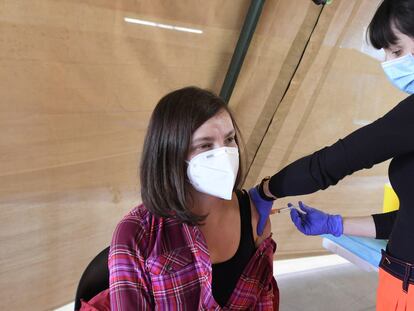Pressure on Spain’s ICUs eases as coronavirus cases fall
The occupation rate of Covid-19 patients in intensive care has dropped to levels not seen since October 2020, but some experts worry there could be a new wave of admissions due to increased social activity


Pressure on intensive care units (ICUs) in Spain is starting to ease as coronavirus cases fall. Infections in May have so far dropped by 28%, while the number of Covid-19 patients in ICUs is at levels not seen since last October, with 1,655 admissions nationally. In other words, 16.8% of ICU beds in Spain are occupied by a Covid-19 patient.
This data point, however, varies greatly between the regions, which are in charge of containing the pandemic in their territories. In Valencia and Galicia, the ICU occupation rate is barely more than 3%, while in Aragón, Catalonia and Basque Country, it is more than 25%. In Madrid, the worst affected region, more than 35% of ICU beds are occupied by Covid-19 patients.
But the general fall in Covid-19 admissions has meant that ICU beds that were set up to deal with the high number of coronavirus cases are starting to be removed: there are 1,000 fewer spots now than on February 1, when there were nearly 5,000 ICU admissions for Covid-19 – the highest figure of 2021.
We are very worried about what could happen with the 40 to 60 age groups, who are the parents of the youngsters who are going out and who are not yet vaccinatedJoan Ramon Masclans, head of the ICU at Mar Hospital in Barcelona
Before the pandemic, the Spanish healthcare system had 4,400 ICU beds, according to the most recent data from the Spanish Health Ministry, which is from 2017. This was not enough to deal with the surge of Covid-19 cases seen at the end of March last year, when the first coronavirus wave was reaching its peak. To create more space for patients in need of critical care, hospitals transformed operating rooms and resuscitation units into ICUs. The figures at that time did not provide a clear picture of the situation in Spain’s ICUs as the regions reported the total number of ICU admissions, rather than how many people were in intensive care at a given moment. This data point, however, still sheds light on the scale of the crisis in Spain’s hospitals: by the end of March 2020, 5,800 Covid-19 patients had been in intensive care. In Madrid, one of the few regions that reported the current number of Covid-19 patients, 1,500 people were in intensive care.
After the first wave, pressure on Spain’s ICUs has fluctuated with each new rise in cases. But the occupation rate has been higher each time a new wave began. This is because the epidemiological curve would rise before admissions to ICUs had started to fall. Spain reached a critical point this year during the peak of the third wave, when Covid-19 patients were occupying 4,894 out of the 10,800 available beds. The pressure started to fall after that point before reaching a plateau during the fourth wave. Now as transmission rates drop and the Covid-19 vaccination drive progresses, the occupancy rate is falling once again.
There are currently 1,655 Covid-19 patients in intensive care, a figure not seen since October 14, when the number was at 1,652. But while the occupation rate is similar to that of October, the epidemiological situation is not. Back then, Spain was facing a new surge in cases, while now the incidence rate is falling – the 14-day cumulative number of cases per 100,000 inhabitants stands at 135. What’s more, more people are protected against the virus thanks to the vaccination drive. With nearly 35% of the Spanish population (16.3 million people) having received at least one dose of the vaccine – a figure that rises to 93% in the case of the over-60s –, the risk of ICUs being overwhelmed again is much lower.

Experts, however, are still concerned that increased social activity following the end of the state of alarm could lead to a new spike in cases. Scenes of youngsters drinking and crowding together on the street after the emergency situation ended on May 9 sparked widespread calls for prudence.
“Seeing the general social behavior, we are very worried about what could happen, especially with the 40-to-60 age groups, who are the parents of the youths who are going out and who are not yet vaccinated,” says Joan Ramon Masclans, the head of the ICU at Mar Hospital in Barcelona, who explains that his unit is at 170% of its structural capacity.
“In Madrid, during the fourth wave, we had 600 critical patients. Now we have 460,” says Alfonso Canabal, the head of the ICU at Princesa Hospital in Madrid. “We have been seeing a slow fall since the end of April, but we need a few more weeks to have a safety margin.”
The experts agree that it is difficult to reduce the pressure on ICUs. While there are fewer admissions, it is taking patients longer to leave. “Now we have young patients and it seems like when they are in a normal ward, the inflammatory process is faster, before it took them 10 days from their arrival to enter the ICU, now it takes three,” says Masclans.
Canabal agrees, explaining that the younger patients “resist the critical stage better [than older patients], but the stays are lasting much longer and that’s why it’s taking time to free up the ICU.”
Return to structural capacity
Of the 10,800 ICU beds at the beginning of February, there are now a little over 9,800. While this is a drop of 1,000, it is still double the number that there was before the pandemic. As coronavirus cases fall, experts explain that it is important to return spaces that were adapted into ICUs to their previous uses. “Having a semi-critical unit or post-surgery resuscitation unit as an ICU means blocking beds for patients who need surgery,” says Masclans.
Canabal adds that it is also important for hospitals to have more structural ICU beds: “The Covid-19 patient is going to stay with us, there will be more variants and this will lead to more pressure on respiratory patients.”
English version by Melissa Kitson.
Tu suscripción se está usando en otro dispositivo
¿Quieres añadir otro usuario a tu suscripción?
Si continúas leyendo en este dispositivo, no se podrá leer en el otro.
FlechaTu suscripción se está usando en otro dispositivo y solo puedes acceder a EL PAÍS desde un dispositivo a la vez.
Si quieres compartir tu cuenta, cambia tu suscripción a la modalidad Premium, así podrás añadir otro usuario. Cada uno accederá con su propia cuenta de email, lo que os permitirá personalizar vuestra experiencia en EL PAÍS.
¿Tienes una suscripción de empresa? Accede aquí para contratar más cuentas.
En el caso de no saber quién está usando tu cuenta, te recomendamos cambiar tu contraseña aquí.
Si decides continuar compartiendo tu cuenta, este mensaje se mostrará en tu dispositivo y en el de la otra persona que está usando tu cuenta de forma indefinida, afectando a tu experiencia de lectura. Puedes consultar aquí los términos y condiciones de la suscripción digital.
More information
Últimas noticias
Pinochet’s victims grapple with José Antonio Kast’s rise in Chile
Reinhard Genzel, Nobel laureate in physics: ‘One-minute videos will never give you the truth’
How Japan is trying to avert ‘digital defeat’
The complicated life of Francesca Albanese: A rising figure in Italy but barred from every bank by Trump’s sanctions
Most viewed
- Pablo Escobar’s hippos: A serious environmental problem, 40 years on
- Why we lost the habit of sleeping in two segments and how that changed our sense of time
- Trump’s obsession with putting his name on everything is unprecedented in the United States
- Charles Dubouloz, mountaineering star, retires at 36 with a farewell tour inspired by Walter Bonatti
- The Florida Keys tourist paradise is besieged by immigration agents: ‘We’ve never seen anything like this’










































